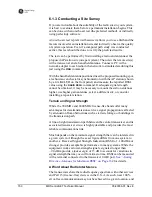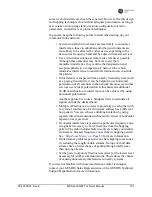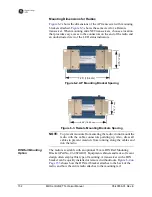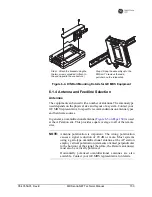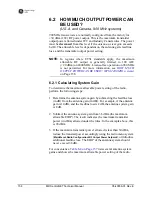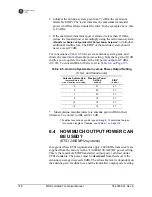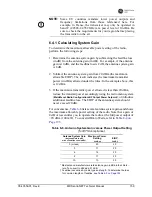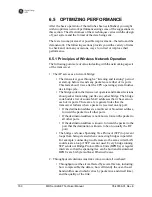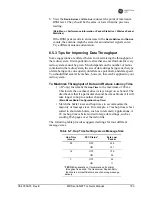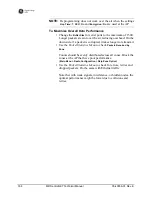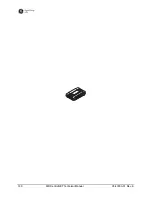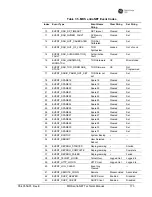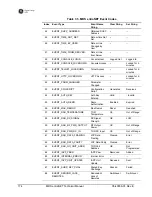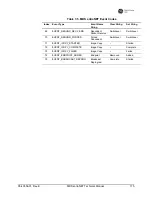
160
MDS entraNET Technical Manual
05-4055A01, Rev. E
6.5
OPTIMIZING PERFORMANCE
After the basic operation of the radio has been established, you might
wish to optimize network performance using some of the suggestions in
this section. The effectiveness of these techniques varies with the design
of your system and the format of the data being sent.
There are two major areas for possible improvement—the radio and the
data network. The following sections provide you with a variety of items
to check and, on many occasions, ways to correct or improve their
performance.
6.5.1 Principles of Wireless Network Operation
The following points are of value in dealing with the networking aspects
of the transceiver.
1. The AP serves as a network bridge:
• The transceiver goes through a “listening and learning” period
at start-up before it sends any packets over either of its ports.
This lasts about 10 sec after the CPU operating system finishes
its startup cycle.
• The bridge code in the transceiver operates and makes decisions
about packet forwarding just like any other bridge. The bridge
code builds a list of source MAC addresses that it has seen on
each of its ports. There are a few general rules that the
transceiver follows when a packet is received on any port:
• If the destination address is a multicast or broadcast address,
forward the packet to all other ports.
• If the destination address is not known, forward the packet to
all other ports.
• If the destination address is known, forward the packet to the
port that the destination is known to be on (usually the RF
port).
• The bridge code uses Spanning Tree Protocol (STP) to prevent
loops from being created when connecting bridges in parallel.
For example, connecting two Remotes to the same wired LAN
could create a loop if STP was not used. Every bridge running
STP sends out Bridge Protocol Data Units (BPDUs) at regular
intervals so that the spanning tree can be built and maintained.
BPDUs are 60-byte multicast Ethernet
frames
.
2. Throughput calculations must take into account all overhead:
• Throughput over the air is affected by several factors, including:
how compressible the data is, how efficiently the over-the-air
bandwidth is used (which varies by packet size and dwell time),
and the quality of the link.
Summary of Contents for MDS entraNET 900
Page 10: ...LA N CO M1 CO M2 PW R LIN K viii MDS entraNET Technical Manual 05 4055A01 Rev E...
Page 12: ...2 MDS entraNET Technical Manual 05 4055A01 Rev E LA N CO M1 CO M2 PW R LIN K...
Page 24: ...14 MDS entraNET Technical Manual 05 4055A01 Rev E LA N CO M1 CO M2 PW R LIN K...
Page 26: ...16 MDS entraNET Technical Manual 05 4055A01 Rev E LA N CO M1 CO M2 PW R LIN K...
Page 38: ...28 MDS entraNET Technical Manual 05 4055A01 Rev E LA N CO M1 CO M2 PW R LIN K...
Page 110: ...100 MDS entraNET Technical Manual 05 4055A01 Rev E LA N CO M1 CO M2 PW R LIN K...
Page 130: ...120 MDS entraNET Technical Manual 05 4055A01 Rev E LA N CO M1 CO M2 PW R LIN K...
Page 156: ...146 MDS entraNET Technical Manual 05 4055A01 Rev E LA N CO M1 CO M2 PW R LIN K...
Page 158: ...148 MDS entraNET Technical Manual 05 4055A01 Rev E LA N CO M1 CO M2 PW R LIN K...
Page 176: ...166 MDS entraNET Technical Manual 05 4055A01 Rev E LA N CO M1 CO M2 PW R LIN K...
Page 186: ...176 MDS entraNET Technical Manual 05 4055A01 Rev E LA N CO M1 CO M2 PW R LIN K...
Page 188: ...178 MDS entraNET Technical Manual 05 4055A01 Rev E LA N CO M1 CO M2 PW R LIN K...
Page 204: ...194 MDS entraNET Technical Manual 05 4055A01 Rev E LA N CO M1 CO M2 PW R LIN K...
Page 218: ...I 8 MDS entraNET Technical Manual 05 4055A01 Rev E...





